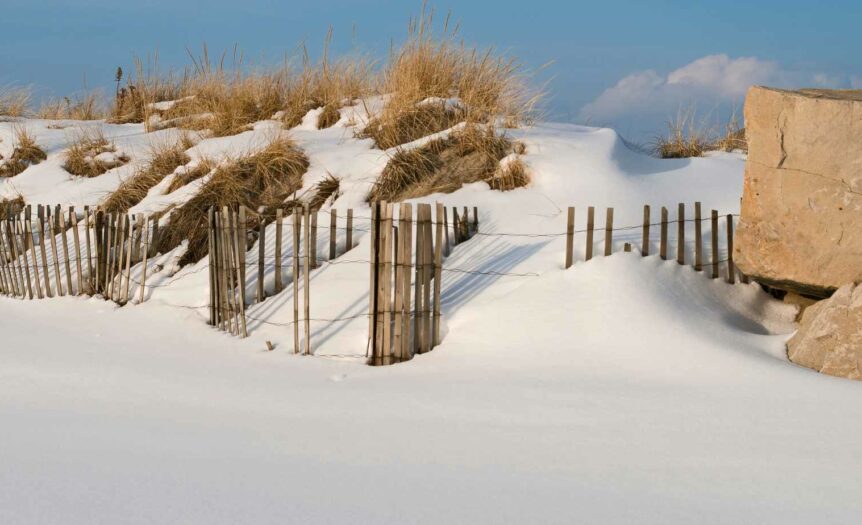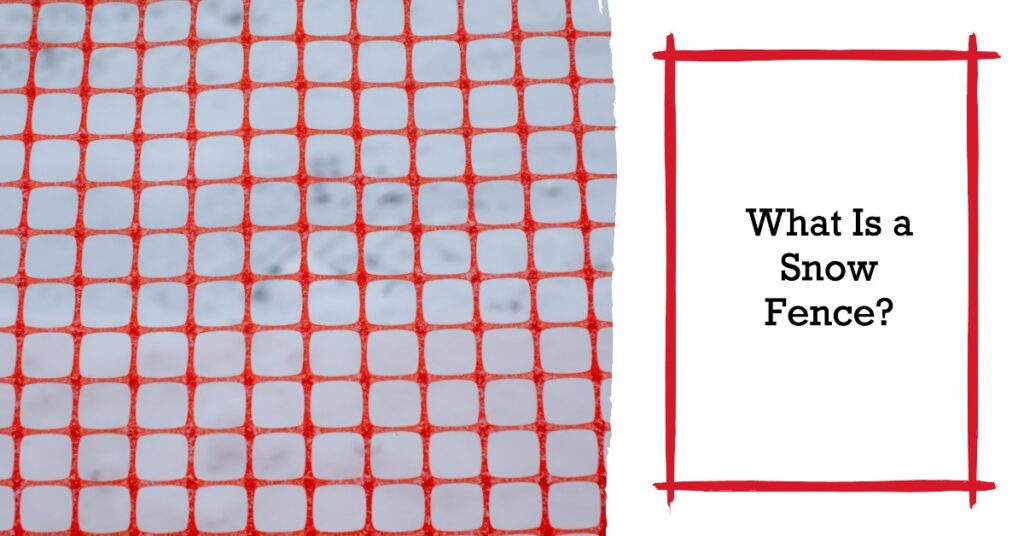Winter months can bring picturesque landscapes and a myriad of outdoor activities, but they also come with the challenges of managing heavy snowfall. One such challenge is the accumulation of snow in unwanted places, obstructing roadways and posing a threat to traffic safety.
Enter the snow fence: a practical solution for controlling drifting snow that has been in use for decades. In this blog post, we will explore what a snow fence is and how it works, delve into different types and materials used, discuss various benefits you may reap from using one on your property or community roadsides, and provide tips on factors to consider when installing them.
What Is A Snow Fence And How Does It Work?
A snow fence is a barrier designed to reduce and control the accumulation of snow and its associated problems, such as drifting and impaired visibility caused by blowing snow, through its ability to disrupt the aerodynamics of the lower level of atmosphere around it.
Definition And Purpose
A snow fence, also known as a windbreak or snow barrier, serves the primary purpose of controlling snow accumulation and drifts in specific areas. By manipulating the aerodynamics of low-level atmospheric winds, these barriers effectively reduce the speed at which the wind can carry snow particles.
In essence, a snow fence works by slowing down the airflow passing through it, causing some of the blowing snow to be deposited on one side of the fence. This creates designated drift zones that keep roadways clear and make highway maintenance more manageable.
In rural settings like farms and ranches, strategically placed fences allow water basins to gradually fill up with melted runoff during springtime – providing an additional resource for irrigation when needed.
Physical Characteristics
Snow fences come in a variety of physical characteristics that make them effective at reducing snowdrifts. The fence material can be made from wood, plastic, metal or fabric depending on the desired use and location.
Moreover, some snow fences have added features to increase their effectiveness against drifting snow. Some open-weave designs allow for more air movement through the fence while still trapping most of the blowing snow.
Others have angled slats designed to deflect wind upwards before it can blow over or around the fence completely.
Aerodynamics Of Snow Fences
Snow fences work by disrupting the aerodynamics of the lowest level of the atmosphere. As wind passes through a snow fence, it slows down and causes some of the snow it’s carrying to drop.
By breaking up the speed of wind, these barriers cause blowing snow to be deposited as drifts where they are stored instead of accumulating on roads or railways. The physical characteristics such as height, porosity, and surface roughness play an important role in determining how much snow will accumulate behind a fence.
For example, taller and more porous fences tend to trap less snow than shorter but denser ones.
In addition to preventing drifting snow on roadways and railways, living snow fences planted with trees and shrubs along highways create natural windbreakers that help keep winter roads clear while preserving landscapes.
Types Of Snow Fences
There are various types of snow fences, such as living snow fences made up of trees and shrubs, fabric snow fences, wooden snow fences, plastic snow fences, and metal snow fences.
Living Snow Fences
Living snow fences are an environmentally friendly way to reduce snow accumulation and drifting on roadways. Natural or designed plantings of trees and shrubs, living snow fences help break up the wind flow by causing it to slow down and deposit some of its snow load in the shadow zone behind the trees.
These natural barriers offer many benefits, including improved road safety by reducing visibility hazards caused by blowing and drifting snow.
Living snow fences are not just limited to highways as they can also serve farm fields and ranches with drift management while simultaneously providing a habitat for wildlife.
The plants used in living snow fences include native species that can survive harsh winters, such as willows or cedars, which makes them both practical for use in rural infrastructure projects as well as aesthetically pleasing additions to any property.
Fabric Snow Fences
Fabric snow fences are made from permeable materials like woven fabric, mesh, and netting. They work by slowing down the wind as it passes through, causing some of the snow it’s carrying to drop.
Fabric snow fences are inexpensive compared to other types of snow barriers and can be installed quickly on short notice.
One benefit of using a fabric snow fence is that they’re available in different heights and lengths. This makes them ideal for installation in areas where there isn’t enough space for taller or wider permanent structures.
Wooden Snow Fences
One of the most traditional materials used in building snow fences is wood. Wooden snow fences are popular because they are sturdy and capable of resisting strong winds.
By strategically placing wooden snow fences upwind from an area, it can create a natural barrier that will cause blowing snow to deposit as drifts where it is stored. This makes them especially useful for ranchers and farmers who rely on a ready supply of water in the spring to irrigate their crops or livestock grazing land.
Wooden snow fences also provide road safety benefits by helping improve visibility in poor weather conditions caused by drifting show.
Plastic Snow Fences
Plastic snow fences are made of lightweight and durable materials, such as polypropylene or PVC, making them a popular choice for temporary snow control. These types of snow fences work by slowing down the wind speed as it passes through their porous surface, causing blowing snow to deposit in drifts where they are stationed.
One example of plastic snow fence usage is near highways during winter months. The installation of these barriers helps reduce the accumulation of drifting snow on roadways, improving visibility for drivers and increasing safety on the roads.
Additionally, plastic snow fences can be used in residential areas to prevent excessive accumulation of drifting off sidewalks and driveways after shoveling efforts have been made.
Metal Snow Fences
Metal snow fences are a popular choice for areas that experience harsh winter weather conditions. Usually, these fences are made of steel or aluminum to withstand the rigors of heavy snow and ice.
The design of metal snow fences is aerodynamic, making it easy for them to resist strong winds effectively. They work by slowing down the speed of wind as it passes through the fence, causing some of the carried snow to drop within the area where it’s needed.
Metal snow fences also help in reducing road accidents caused by reduced visibility during heavy storms.
Benefits Of Using A Snow Fence
Using a snow fence offers several benefits, including enhanced road safety by reducing visibility hazards and preventing snowdrifts on highways, reduced snow removal costs through proper management of accumulated snow in designated areas, preservation of landscapes by minimizing erosion caused by heavy snowfall, and energy savings resulting from the efficient use of stored winter resources.
Enhanced Road Safety
Snow fences are essential for enhancing road safety during the winter months. By minimizing snowdrifts on roads and highways, these barriers minimize accidents caused by decreased visibility or black ice formation.
In addition to preventing snow from accumulating on roads and highways, snow fences also help maintain safe driving areas with good traction by keeping drifting snow away from road edges.
Overall, using snow fences is an effective way to ensure that drivers stay safe during hazardous winter weather conditions.
Reduced Snow Removal Costs
One of the major benefits of using a snow fence is its ability to reduce snow removal costs. When snow accumulates in unwanted places, such as on roadways or railways, it not only poses a safety hazard but also requires significant resources to remove.
This means less time and money spent on expensive equipment and labor for plowing, shoveling or hauling off accumulated snow. For example, highway departments that have implemented effective living snow fences have reported savings up to $260 per kilometer annually due to reduced salt usage and plow truck maintenance.
Preservation Of Landscapes
Snow fences can help preserve the natural beauty of landscapes by minimizing the need for extensive snow removal. In many areas, such as rural communities and mountainous regions, snow drifts are a common occurrence during the winter months.
Without proper management, these drifts can be damaging to plants and trees, disrupting delicate ecosystems.
This method is particularly useful for those who live in agricultural or ranching communities where preserving the land is crucial for maintaining their way of life. For example, farmers may use snow fencing to create basins that collect drifting snow which melts into groundwater reserves they rely on in dry seasons.
Energy Savings
Snow fences can help with energy savings in a multitude of ways. By preventing snow from accumulating on roadways and railways, less fuel is needed for snow removal equipment like plows and blowers.
In addition, snow fences can be strategically placed to create drifts in specific areas, such as basins or designated spots. These drifts can then be used as a natural source of insulation during winter months, keeping buildings warmer without relying solely on heating systems.
Overall, by using snow fences effectively, individuals and communities alike can reduce their carbon footprint while saving money on energy costs.
Factors To Consider When Installing A Snow Fence
When installing a snow fence, it’s crucial to consider wind patterns and drifts, strategic placement, material and design choices, as well as maintenance tips to ensure optimum performance.
Wind Patterns And Drifts
Snow fences are effective in managing drifting snow, but they need to be strategically placed in areas that experience the strongest wind patterns. The fence slows down the wind as it passes through, causing some of the snow it’s carrying to drop.
Drifts typically form on the leeward side of a barrier, which is why proper placement is crucial.
In Colorado, for example, where snowfall can exceed 300 inches annually in high-elevation regions like Rocky Mountain National Park, highways and roads require robust snow management systems that include both physical barriers like fences and advanced plowing techniques.
For instance, strong prevailing winds often come from west to east across North America; thus installing a fence perpendicular or at an angle to this pattern could significantly reduce blowing snow deposition on roadways.
Strategic Placement
Strategic placement is essential when installing a snow fence. It’s crucial to place the fence in an area where it can effectively stop snow from drifting onto the road or highway.
For instance, if most of the wind blows from one direction, you want to install your fence perpendicular to that direction so that it catches any blown snow coming from that way.
It’s wise to install a snow fence at least ten times its height away from driveways and roadsides because this prevents drifted snow from blocking passing vehicles’ view on highways.
Additionally, choosing suitable materials and designs ensures longevity during harsh winter conditions with minimal maintenance needed.
Material And Design Choices
Snow fences come in different materials and design choices that depend on the specific needs of a snow management project. The most common materials used for temporary snow fences are wood, plastic, and fabric.
Wooden snow fences have been used for many years because they are relatively cheap and can be reused over time. Plastic snow fences are lightweight, easy to install, and resistant to temperature changes.
Permanent snow fences may also include metal options such as chain link and wire mesh fencing. These types of barriers provide strength and durability for long-term use in areas with heavy winter weather conditions.
For example living fence designs incorporate shrubs or trees arranged strategically in a particular direction while providing an attractive natural barrier against harsh winds drifting accumulated amounts of blowing snow allowing its deposition without blocking essential view lines along highways while maintaining wildlife habitats or ecosystem services contributing to preservation efforts furthering landscape conservation goals.
Regardless of material choice or design choice made by contractors installing these structures municipalities must ensure maintenance practices support their longevity like painting treated lumber surfaces regularly replacing missing components tightening loose fasteners checking supports/posts stability etc., so that they remain effective at managing drifts protecting transportation infrastructure rural economies ensuring public safety during winter months across challenging terrain across North America’s cold climactic zones with significant accumulations each year annually often at risk due to drastic climate changes now taking place globally affecting diverse regions worldwide.”
Maintenance Tips
To ensure that your snow fence functions efficiently, it’s vital to carry out regular maintenance. Regular inspection of the fence is necessary to identify any damage or weakness caused by harsh weather and other elements.
In areas with consistent heavy snowfall, clearing the accumulated snow from the fence will help maintain its structure and effectiveness. Keeping an eye on vegetation growth around the fence is also crucial as overgrown plants can weaken or damage the structure of the fence.
By taking these simple maintenance steps, you can extend your snow fence’s lifespan while reducing overall costs associated with road safety measures and snow removal efforts.
Conclusion
In conclusion, a snow fence is a barrier designed to prevent snow from blowing onto roads and railways. It slows down the wind, causing it to drop some of the snow it’s carrying.
There are different types of snow fences, including living ones made up of trees and shrubs, as well as fabric, wood, plastic and metal options. Using a snow fence comes with several benefits such as improved road safety by enhancing traffic visibility or reducing costs associated with snow removal but requires strategic placement consideration in regards to wind patterns and drifts.







